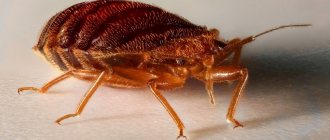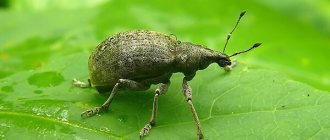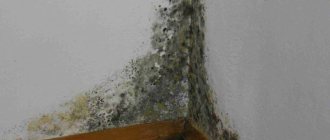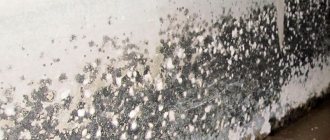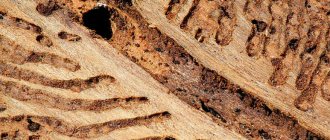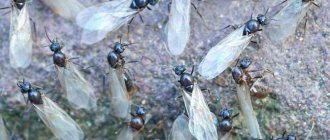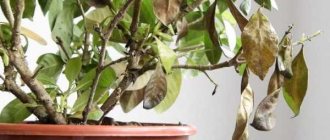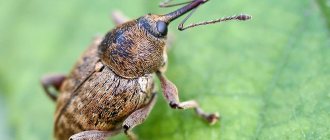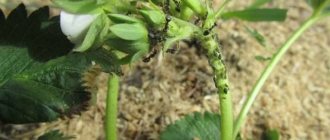Fungus on walls is a living organism. Any room contains spores of various fungi and molds, and as soon as a favorable environment for their reproduction arises, they immediately begin to germinate. Fungi reveal themselves as a black coating on the walls of the room, on window sills and slopes, on the seams between the tiles in the bathroom. Areas affected by mold damage spoil the aesthetic appearance of the apartment, and most importantly, harm your health.
A solution of copper sulfate will help remove mold from a concrete wall.
When mold grows, large amounts of fungal spores are released into the air. This has a particularly harmful effect on children or people with weak immune systems, causing allergic reactions, skin diseases, bronchial asthma, aspergillosis and even oncology. If fungus is found on the walls in a room, it must be dealt with immediately.
What is this
Fungus and mold that “attack” the walls of a building are colonies of simple microorganisms that become visible due to their obvious abundance. They are characterized by high vitality, the ability to reproduce due to moisture in the atmosphere, and no need for sunlight. Thanks to these properties, microorganisms grow very rapidly, and the inhabitants of the house are faced with the question: “How to remove fungus from the walls in the apartment?”
Fungus and mold
What causes fungus to appear on the walls in an apartment?
Residents of communal houses often observe peeling plaster, peeling wallpaper, or simply an unpleasant odor in the room. It's all due to high humidity. The increased water content in the air allows microorganisms to develop more actively, hence the whole problem.
Most people's bathrooms and living rooms are equipped with a weak ventilation system that simply cannot remove all the moisture.
IMPORTANT: The fungus actively reproduces at temperatures of 15-20 degrees, with air humidity over 70%.
Types of mold
Mold fungi can live and develop on various surfaces: concrete, wood, fabrics, stone, varnish and paint. Under favorable conditions, several types of harmful microorganisms can attack one apartment at once. The most famous are:
- White house mushroom. A dangerous enemy of wooden buildings, capable of destroying the structure as quickly as possible with rapid development. Very difficult to destroy;
- Black mold. Appears in the form of dark blots of various colors. It grows rapidly, filling the space with a mass of spores. It is considered the most dangerous mushroom for human health;
- Blue fungus. Gives walls a grayish-blue tint. Capable of deforming the paintwork, drawing moisture from the inside;
- White mold. Capable of forming on various materials and damaging them as quickly as possible;
- Actinomycetes. They soften and gradually destroy the wood;
Rotting fungi. Characteristic only for wood materials. There are dry and wet rot. The first type of damage manifests itself in a brown tint, compression and splitting of the wood. Damage to wet rot is indicated by dark bands and subsequent cracks.
Fungus on the walls
Where does mold most often appear?
The fungus settles only where there are favorable conditions for this. The following rooms will be the “favorites” for mold:
Bathroom (bathroom) - this is where the air circulates worst, and its humidity is high.
Kitchen – when cooking and washing dishes, a lot of moisture is released, and the room is not always properly ventilated. Special attention should be paid to sponges for washing dishes, because they often do not dry completely.
Window frames - to be more precise, the slopes near them. In winter and autumn, when there are sharp temperature changes, moisture forms on the windows, which settles and turns into small black dots.
Causes of mold
In order to understand how to remove fungus from the walls of an apartment, it is worth deciding on the reasons for its formation. The appearance of microorganisms can be caused by several factors:
- Room humidity is above 60%;
- Lack or insufficient heating in the house;
- Small thickness of the walls, unable to protect them from freezing in frosty weather;
- Improper laying of bricks or joining of reinforced concrete slabs;
- Uninsulated window slopes;
- Poor quality installation of plastic windows;
- Little or no air circulation;
- Poor quality waterproofing of foundations in private buildings.
How does fungus and mold appear on walls?
• A faulty ventilation system allows humidified air to settle on any surface. Air currents move slowly, which causes their accumulation. Under suitable temperature conditions, the process that generates fungi is activated.
• Constant dampness under the building itself is also an excellent breeding ground for fungus. Increased soil humidity and temperature allows microorganisms to develop quickly. They enter the room through ventilation ducts.
• Violation of the integrity of the sewer system increases the humidity of the basement. If fungal growths are found here, you should check the foundation insulation. If there is no damage, a good ventilation system is created and repairs are carried out.
• In addition to sewer pipes, it is important to check the plumbing routes themselves. Pipes that leave streaks on the walls contribute to the development of fungus.
• If the building was erected from a material with high thermal conductivity, then freezing of the walls in winter will increase the humidity of the premises in the spring. When the temperature outside rises, the frozen moisture in the walls begins to move and gets inside the building.
High humidity and temperature are the cause of the formation of fungus or mold on any surface.
Negative effects of mold on humans
Treating walls against mold is required not only to protect the room. The fungus poses a considerable danger to the human body. It constantly releases microscopic spores, which, spreading throughout the house, land on the skin and fly into the lungs.
The spores contain toxic substances, contact with which can cause serious problems for people. The list of ailments caused by mold is quite extensive: runny nose, headache, allergies, asthma, persistent cough, nausea. Contact of moldy fungus with the elderly, children and those with a weak immune system is particularly dangerous.
There's one mushroom here
Harm from mold
It is very important to remove mold in the apartment in a timely manner, as it penetrates the human body and provokes many diseases.
Read here Holofiber - properties of the material, washing rules and features of caring for things with holofiber (105 photos)
The most common illness caused by fungi is allergies. The severity depends on the susceptibility of the body. Most often it affects children and the elderly.
What other diseases are caused by mold:
- Bronchial asthma.
- Skin rashes.
- Migraine.
- Gastrointestinal disorder.
- Pneumonia.
- Liver and kidney diseases.
- Respiratory diseases.
Prevention
Mold forms in damp places. It can be found especially often in the bathroom, in the joints between the tiles.
A good preventive measure against mold and mildew on walls is to ensure an optimal microclimate. If natural ventilation is not enough, it is recommended to install special equipment in the ventilation duct.
You should not “throw” wet things around the apartment. They need to be dried unfolded on a special stand or on a stretched rope.
Cold bridges can trigger the formation of mold. External insulation will help prevent their occurrence. The discovery of fungus on the balcony usually indicates defects in the installation of the drain and poor-quality waterproofing.
If you find places where the paint has begun to peel off and swell, it is necessary to clean them from the paint coating, treat them with an antiseptic composition and apply a new coat of paint.
Fungus caused by leaks
Types of mold in apartments
Black mold
Black mold on walls is the most common. There are 8 different types of fungus known, which turn black depending on the stage of development and the material on which they parasitize.
Black is considered the most dangerous to human and animal health. Destructive for building materials. It is difficult to remove mold of this color because it is not picky about the conditions for its growth.
White mold
The most harmless one. Rarely appears on walls, and usually lives in flower pots. In appearance, it is soft and does not crumble. It looks like fluff or a film that is easy to smudge.
It is important to remember this characteristic!
Because white fungus is often confused with white efflorescence on the wall. The latter crumble when crushed, grow on the wall and fall apart! Read about it in the next paragraph.
Lifekah! To combat mold in indoor plants, water them with water with a little citric acid added. After the plaque disappears, you can return to normal moisturizing.
Efflorescence
White plaque on the walls, which usually occurs on the facades of buildings. It has a crystalline structure and crumbles easily by hand. Rarely, but there is a colored one.
It occurs where water and salts circulate along the walls. In dry, warm weather, water evaporates, and salts and alkalis remain on the surface, forming build-ups.
Efflorescence is not harmful to human health. But they quickly destroy buildings. Not all crystals come to the surface. Some part settles inside building materials and wedges them from the inside, forming cracks. Affects brick, concrete, stone, marble, plaster.
Blue fungi
Blue-green rot on wood. The most insidious thing about it is that it even corrodes paint or varnish. These holes become a conductor of water into the wooden wall. And already in this humid environment the fungus grows even more.
Actinomycetes
Mold is a middle ground between fungi and algae. It multiplies in wet wood, destroying it to dust.
If you are looking for a way to get rid of mold on the walls in your apartment, then you need to accurately determine that it is not actinomycetes.
Their habitat is humidity. If you mistakenly take medications designed to combat dry fungus, the result will be exactly the opposite. Create a favorable environment where it will grow even more extensively!
Features of work on various surfaces
Treating apartment walls against fungus and mold has its own nuances depending on the type of surface.
Painted canvases must be removed from cracked and swollen paint. If this is not done, then the spores hidden under the coating will sooner or later appear on the surface again.
Things are a little more complicated with suspended ceilings and drywall. The porous surface allows the fungus to penetrate deeply. In particularly difficult situations, the affected surface must be completely replaced.
If the wallpaper is covered with mold, it is also necessary to remove it and then treat the wall with an antiseptic.
Fungus and mold
The most dangerous types of microorganisms
When living in an apartment or private house, you can encounter 3 types of microorganisms, namely: • Mold • Blue mold • Rot
Mold is found on materials made of stone, concrete or coated with paint. This type of fungus differs in appearance. They appear on the surface in spots or dots. Their coloring can be black, blue, green or brown. Mold can destroy any building material to the ground; it is enough to create suitable conditions for this.
Blue stain is dangerous for any building materials with a high density. Such fungi penetrate into the structure of the product, forming small channels behind them. Due to the increased humidity in the room, they easily “eat” their way into neighboring elements, and this affects the strength of the entire structure. Coniferous wood species, especially pine, are most susceptible to the effects of these microorganisms.
Of the building materials, only lumber can rot Rot can be: white, brown and bacterial. For wooden buildings, white microorganisms are the most dangerous. They are able to “eat through” a board 40 millimeters thick in just a month.
Brown rot creates cracks in the lumber, allowing moisture to penetrate more deeply. Once the integrity of a wooden element is damaged, its strength is significantly reduced, and the area around the crack darkens. As for bacterial rot, it affects the material from the inside.
White rot is the main enemy of all lumber. For this reason, more than one residential building was burned. At a time when there were no antiseptic solutions, houses with white rot were simply burned so that it would not spread to neighboring buildings.
You can also find wet and dry types of rot. The first forms black, brown or yellow stripes on the surface of the wood. Immediately after their appearance, cracking of lumber occurs. Dry rot turns wood brown and delaminates along or across the grain.
Sequence of repair activities
Before you start planning and thinking about how to remove fungus from the walls, it is recommended to carry out a number of preparatory activities. Porous surfaces require special attention.
- Work begins with removing old wallpaper;
- Then you need to thoroughly clean the “sick” area with an iron spatula or brush, completely removing the loose plaster;
- Treat the canvas with a cleaning composition to open the cement pores;
- Apply the anti-mold and mildew agent on the walls until the surface is well saturated;
- Prime the canvas with a deep absorption antiseptic;
- After waiting for the solution to harden, repeat the priming procedure;
- Plaster, prime and putty the walls;
- Perform final wall cladding.
Removal of moldy fungus in the cellar is accompanied by drying and waterproofing of the room.
Instructions: how to get rid of fungus on walls
When you know how to treat walls against fungus, you need to figure out how it will be done. Walls covered with plaster are tapped. It is important to determine the place where the frozen mortar is peeled off from the base.
Most likely, active reproduction of microorganisms occurs in this area. When removing plaster, do not be afraid to chip off more than necessary, fungi can spread, and there is a possibility of finding several more infected areas. Ideally, you need to remove all the mortar from the wall, this is the only way to be sure of the work done.
• Having cleaned the surface of the wall down to the base, you need to moisten it. This will prevent fungal spores from scattering throughout the room. • Next, the surface is cleaned. To do this, you can use a wire brush or coarse sandpaper. • After removing obvious areas of infection, begin treating the surface with a solution. The choice of substance for treatment will depend on the resident himself; everything here is individual. It is worth noting that if the wall has been exposed to microorganisms for a long time, then it is better to treat it in several stages. • After finishing the wall treatment, a good inflow and outflow of air is created, so the surface will dry faster. The room in which the work was carried out cannot be used for two days.
Remember that the fungus negatively affects the human body. During work, it is important to equip the worker with personal protective equipment: a respirator, goggles, gloves and clothing made of thick fabric.
How to treat walls (Folk methods)
You can try to remove local damage to walls using relatively harmless and affordable folk remedies. Even ordinary peroxide and furatsilin can become worthy helpers.
All work on cleaning walls containing fungal mold must be carried out strictly using rubber gloves and a protective gown.
Recipes
- 0.5 cups white vinegar, 4 tbsp. l. borax and 4 tbsp. Stir warm water until smooth. Spray the resulting remedy for fungus on the walls onto the affected surface, let it sit for a while (5-10 minutes), wipe dry and repeat the procedure.
- Treat the affected canvas several times with vinegar at intervals of 1 hour.
- Mix 100 grams of bleach and a liter of water. Apply the resulting solution to smooth, mold-affected surfaces. Wait a little, rinse and repeat the procedure a couple more times.
- A decent remedy against fungus on walls is 3% hydrogen peroxide. It is necessary to take into account the fact that the liquid has bleaching properties.
Folk remedies do not provide a 100% guarantee of fungal removal, but are quite effective at the initial stage of the infection.
Preparations of chemical origin
Today, many chemicals are produced, so the question is: “How to treat walls against mold?” Shouldn't cause any big problems. The choice of a suitable composition should be accompanied by a study of the instructions, since the chosen product for removing fungus and mold on the walls may be suitable only for a certain type of microorganisms.
Chemical compounds with antifungal and antimicrobial characteristics are considered the most effective. You can purchase both ready-made preparations and mixtures that require preliminary preparation. You can dilute the antiseptic against mold and mildew on the walls with turpentine, clean water or white alcohol. Oil-based formulations (for example, creosote) are quite popular.
Top most effective antiseptics for mold
- Stop mold (Olympus) is an aggressive composition recommended mainly for cellars, bathrooms and other overly damp rooms. Colorless, safe for pets and people, does not contain toxic or chlorine compounds. Suitable for almost any surface.
- Abedis 06 is a fairly toxic drug that can kill any type of fungus. Does not change the quality of facing materials. Apply to the affected area for a day and wash off with water.
- Fongifluid Alpa is an active fungicidal agent against fungus on the walls in the apartment. Sold in ready-made liquid form. Made with anti-mold and antifungal ingredients.
- The biocide is an effective drug that gets rid of primary and secondary fungal colonies. It is used based on the following ratios: 70-100 ml/m2. In addition to the main components, it contains pleasant flavors.
- Xiolate is the drug with the best results. It acts on the basis of penetrating isotopes, destroying the structure of mold in the very depths of building materials.
- Teflex is a powerful drug that is safe for humans and pets.
If the area affected by fungus and mold is too extensive, then complete disinfection of the room is required using the cold or hot fog method. The substance contains a generated active form of a disinfectant that can destroy microorganisms anywhere in the building.
Classification of fungi
Types of blue on a tree.
Most often in everyday life a person encounters the following types of fungi:
- Mold fungi grow on concrete and stone painted surfaces. They manifest themselves in areas colored black, brown, blue or green. Such mold can completely destroy the materials used in construction and finishing;
- Blue fungi attack wood material. The walls become gray-blue. Penetrating through the varnished surface, they allow water to follow them and mold to grow. Among tree species, pine is especially unstable to the effects of blue fungus;
- Decay fungi primarily damage wood materials. Rotting fungi are bacterial, brown and white. When infected with bacterial rot, the wood is destroyed from the inside, the wall becomes dark gray, and the strength of the wood decreases. If the wall is damaged by white rot, the cellulose is completely destroyed. In 1 month, even thick oak boards can become unusable. Brown rot spores cause wood to split.
Remedies for black mold
To destroy the fungus, you can use special remedies for mold on the walls or traditional methods. The fight against dangerous microorganisms sometimes takes a long time, as they tend to eat deep into materials.
Special
Store-bought preparations used to kill mold contain antifungal and antiseptic elements. They destroy spores and prevent their secondary appearance . A suitable product is purchased depending on the degree of damage to the surface, the type of fungus, and the size of the area to be treated.
- Rogneda Dali. Quickly and effectively destroys fungus that has settled in any corner of the house. Used for cleaning concrete, brick, and wooden surfaces. Can be used to prevent re-infection, and also as a product that is applied before painting walls.
- ALPA Fongifluid. An effective, potent drug that destroys moss, mold, and fungi. It is an excellent prevention of re-infection. Applied to wood, concrete, stone, brick, plasterboard, ceramics, tiles. The product can be used to treat plastered and puttied walls.
- OLIMP stop Mold. A product designed to eliminate biological growths, including moss and lichen, from various surfaces. It is distinguished by the absence of color after processing and is absolutely safe for the health of people and animals. Contains acrylic dispersion, biocides, target components.
- Eskaro Biotol spray. A fungicide designed to kill moss and mold. Suitable for painted and unpainted stone, concrete and wooden walls. Does not contain toxic components, has no repulsive odor, and does not interfere with natural air exchange. Can be used for treating external walls, architectural monuments, window sills, roofs, etc.
When using specific antifungal drugs, you must carefully study the instructions and follow the manufacturer's recommendations. Processing should be carried out wearing personal protective equipment.
Folk
Most folk remedies contain antiseptic substances that can destroy fungal cells and prevent their recurrence. They are not as effective as specific drugs, but are considered safer and more accessible.
- Vinegar. Fill the spray bottle with acid and treat the fungus-contaminated surface. After an hour, wash off with water. The procedure is repeated several times in a row.
- Hydrogen peroxide . The solution contains no life-threatening substances or toxic odors. The preparation is applied to the areas of mold growth and left for 2-3 hours.
- Ammonia. The product works well on flat surfaces. It is diluted with water at a ratio of 1 to 1, applied to problem areas and washed off after a few hours.
- Baking soda. One large spoon of soda is required for one glass of water. The area covered with fungi is watered with a solution, and after a while it is washed off with water.
- Copper sulfate. An effective product that quickly and reliably removes mold from any surface. The powder is diluted 1 to 1. Do not wash off after application.
- Tea tree oil. The solution has antiseptic properties. The oil is diluted with water in a ratio of 1 to 50. The resulting composition is applied to the problem area, ensuring good ventilation. Within a few hours, the foreign smell will evaporate and the mold will go away.
Bleach or bleach works no less effectively . The product instantly destroys mold, but has a pungent, harmful odor.
Valera
The voice of the construction guru
Ask a Question
Hydrogen peroxide, chemicals, and bleach change the color of surfaces, so they are used especially carefully on painted walls. In addition, they provide a temporary effect, unlike professional drugs.
